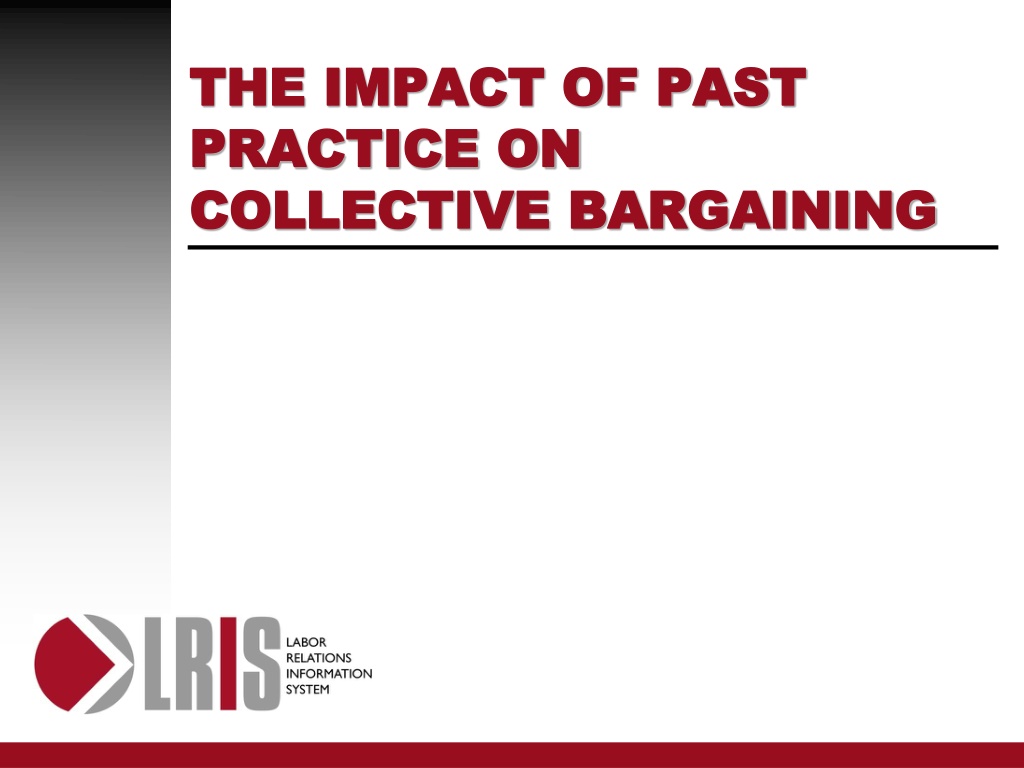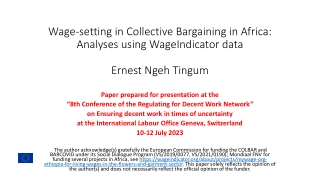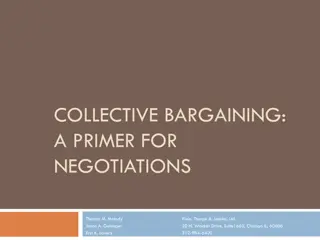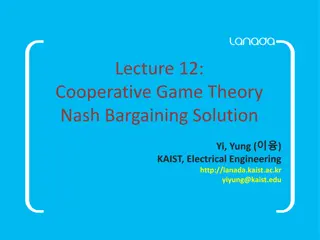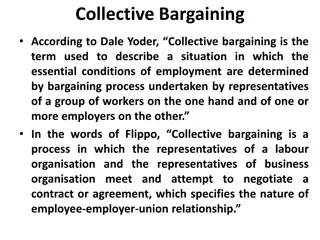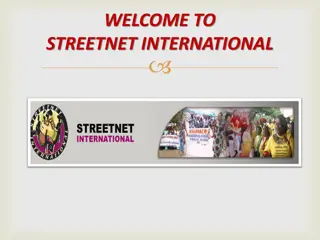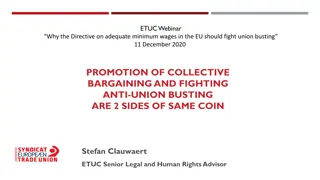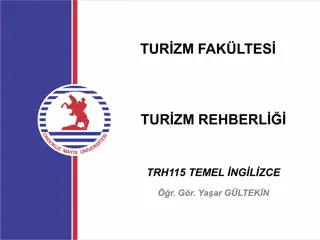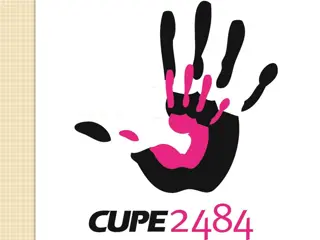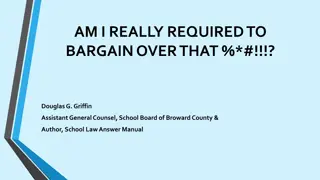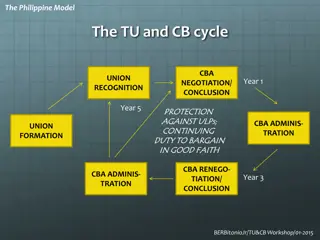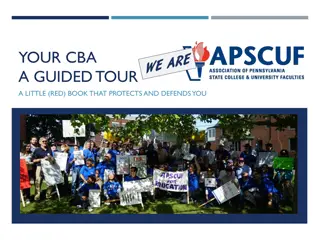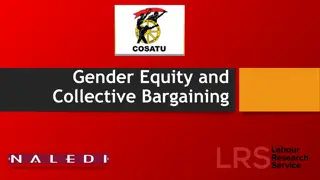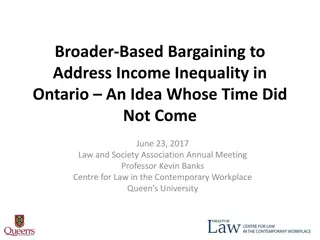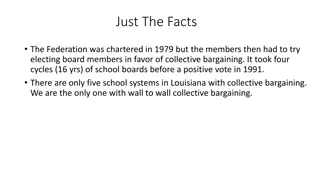Understanding the Impact of Past Practices on Collective Bargaining
Exploring the significance of past practices in interpreting, supplementing, and potentially contradicting contract language within the context of collective bargaining. Covering topics such as the definition of past practices, the duty to bargain, waivers of protest rights, and remedies for unlawful changes. Examining typical past practice issues like changes in pay calculations, work schedules, job duties, and more based on clear criteria detailed by Elkouri and Elkouri. Delving into the importance of consistency and clarity in establishing binding past practices even in unconventional situations.
Download Presentation

Please find below an Image/Link to download the presentation.
The content on the website is provided AS IS for your information and personal use only. It may not be sold, licensed, or shared on other websites without obtaining consent from the author. Download presentation by click this link. If you encounter any issues during the download, it is possible that the publisher has removed the file from their server.
E N D
Presentation Transcript
THE IMPACT OF PAST THE IMPACT OF PAST PRACTICE ON PRACTICE ON COLLECTIVE BARGAINING COLLECTIVE BARGAINING
PAST PRACTICES WHAT WE LL COVER What is a past practice? How a past practice can be used to interpret, supplement, and perhaps even contradict contract language. Past practices and the continuing duty to bargain. Waivers of the right to protest changes in past practices. Remedies where past practices have been unlawfully changed.
A TYPICAL PAST PRACTICE ISSUE Nothing in the employer s rules says anything about employee tattoos or body piercings. The employer receives citizen complaints about employee tattoos the citizens find offensive. In response, the employer requires all employees with tattoos on their arms to wear long-sleeve shirts while on duty. Anticipating similar problems, the employer bans all male employees from wearing body piercing jewelry while on duty.
OTHER TYPICAL PAST PRACTICE ISSUES Changes in pay calculations or pay periods. Changes in work schedules. Changes in job duties. Subcontracting. Changes in disciplinary rules. Changes in insurance benefits. Residency rules.
WHAT IS A PAST PRACTICE? From How Arbitration Works, by Elkouri and Elkouri: A past practice must be (1) unequivocal; (2) clearly enunciated and acted upon; and (3) readily ascertainable over a reasonable period of time as a fixed and established practice accepted by both parties. Another definition requires clarity, consistency, and acceptability, with clarity speaking to uniformity, consistency speaking to repetition, and acceptability involving the sense of mutuality of the practice.
WHAT DOES CONSISTENT MEAN Close to absolute consistency is necessary. If the employer does something 75% of the time, there is no binding past practice. For example, if the employer had required one employee cover up an objectionable tattoo obtained prior to employment, how would the consistency of the past practice be evaluated?
WHAT IS A CLEAR AND KNOWN PAST PRACTICE? A past practice is clear if it is known to both parties. What does known mean? Can a binding past practice . . . Be established in a fire department if the employer s HR or labor relations entity is unaware of the practice? By mistake? By the actions of a third party?
HOW LONG DOES IT TAKE TO ESTABLISH A PAST PRACTICE? The inverse relationship the more frequently an event occurs, the less time it takes to establish the event as a past practice. Something that occurs once a year will take years to establish as a past practice. Something that occurs daily may only take months to establish a past practice.
THE USES OF PAST PRACTICE, AMBIGUOUS CONTRACT LANGUAGE Where contract language is ambiguous, virtually every arbitrator will use past practice as an extrinsic aid to interpretation. Past practice and bargaining history are probably the most important extrinsic aids to contract interpretation.
THE USES OF PAST PRACTICE, AMBIGUOUS CONTRACT LANGUAGE How ambiguity is judged. The starting point: Collective bargaining agreements are a type of contract, and their interpretation is governed primarily by principles of contract law adapted to the bargaining context. According to one of those principles, where contract language is clear and unambiguous, the clear meaning must be given effect.
THE USES OF PAST PRACTICE, AMBIGUOUS CONTRACT LANGUAGE How post-bargaining conduct impacts the past practice assessment: A practice that develops after the addition of ambiguous contract terms may likewise evidence what the parties thought would result from the language being adopted. The presumption is that the parties intended meaning is reflected in their subsequent application of the contract language. Mittenthal, "Past Practice and the Administration of Collective Bargaining Agreements," 59 Mich. L. Rev. 1017, 1025 (1961).
EXAMPLES OF UNCLEAR CONTRACT LANGUAGE Patrol officers may be scheduled to work a 5/8 or 4/10 shift. Does this language give the employer the right to unilaterally change employees from one shift to the other?
EXAMPLES OF UNCLEAR CONTRACT LANGUAGE Where the shift strength is reduced or increased on holidays, consistent with the needs of the City, assignments shall be offered to the most senior firefighter. Does this language apply only to firefighters, or to bargaining unit fire lieutenants and captains?
EXAMPLES OF UNCLEAR CONTRACT LANGUAGE As used in this Contract, overtime means time an officer is authorized to work in excess of eight (8) hours in a work day, or forty (40) hours in a work week. An officer takes two hours of vacation at the start of the shift, and then works four hours after the end of her shift. Does the two hours of paid leave count as time the officer is authorized to work?
THE USES OF PAST PRACTICE, IMPLIED CONTRACT TERMS Where a contract is completely silent on an issue, past practice can create an implied term of the contract. Arbitrators are split on whether this is a permissible use of past practice, though the majority of arbitrators believe a clear past practice can become an implied contract term. Example: Though the contract is silent on the issue, the employer has consistently reimbursed employees at the IRS rate for mileage.
THE USES OF PAST PRACTICE, CONTRADICTING THE CONTRACT Some find that a past practice can even contradict the explicit terms of a contract. Important factors are the length of the practice, and intervening bargaining opportunities. Example: The contract specifies a $10 prescription co-pay. For years, the co-pay has actually been $15.
THE USES OF PAST PRACTICE, CONTRADICTING THE CONTRACT Words from the leading court decision: To require a party to bargain anew before enforcing a right set forth in the contract requires proof that the parties knowingly, voluntarily, and mutually agreed to new obligations. To vary the clear written mandates of the contract, the understanding or past practice must be evidenced by substantially stronger evidence than when utilized to interpret ambiguous language or to fill in areas where the contract is silent. Port Huron Education Ass n v. Port Huron Area School District, 452 Mich. 309, 550 N.W.2d 228 (Mich.1996).
PAST PRACTICE AND THE PAST PRACTICE AND THE CONTINUING DUTY TO CONTINUING DUTY TO BARGAIN BARGAIN If a matter is a mandatory subject for bargaining, an employer may not make changes in past practices affecting the matter without first negotiating with the labor organization representing employees unless the labor organization has waived the right to bargain.
THE CONTINUING DUTY TO THE CONTINUING DUTY TO BARGAIN, APPLICABILITY BARGAIN, APPLICABILITY The continuing duty to bargain applies before the parties have negotiated their first contract. Example: Employees decertify their incumbent labor organization and select a new union. Before the first contract is signed, the employer changes shift schedules.
THE CONTINUING DUTY TO THE CONTINUING DUTY TO BARGAIN, APPLICABILITY BARGAIN, APPLICABILITY The continuing duty to bargain applies after the parties contract has expired, and before a new contract is ratified. Example: After a contract expires, the employer terminates an employee without just cause. How an evergreen clause plays into this scenario.
THE CONTINUING DUTY TO THE CONTINUING DUTY TO BARGAIN, APPLICABILITY BARGAIN, APPLICABILITY The continuing duty to bargain applies during the term of the contract to mandatory subjects of bargaining that are not specifically addressed in the contract. Example: The contract is silent on the issue of residency, and the voters amend the employer s charter to impose a residency requirement.
WAIVERS BY CONTRACT WAIVERS BY CONTRACT Waivers by contract must be both specific and clearly articulated. Waivers must be specific to the subject matter that is involved. Waivers must consist of language that clearly articulates that a labor organization has waived the right to bargain over changes in the area. A waiver must be an intentional relinquishment of a known right with both knowledge of its existence and an intention to relinquish it.
THE CONTINUING DUTY TO THE CONTINUING DUTY TO BARGAIN, RESTATEMENT BARGAIN, RESTATEMENT If something is a mandatory subject for bargaining, an employer may not make changes in past practices affecting the matter without first negotiating with the labor organization representing employees unless the labor organization has waived the right to bargain.
WAIVERS BY CONTRACT WAIVERS BY CONTRACT To be enforceable, contract waivers must be clear and specific. Management rights clauses. The City shall retain the exclusive right to exercise the customary functions of management including, but not limited to . . . (a list of functions) Zipper or complete agreement clauses. This Agreement spells out the total agreement in its entirety between the parties, including wages, salaries, pensions and all fringe benefits.
WAIVERS BY CONTRACT WAIVERS BY CONTRACT Management rights and zipper clauses are frequently cited as the dual bases for a defense of waiver by agreement and are most often rejected. Without supporting evidence in other substantive provisions of the contract, the parties' negotiating history, or past practice, catch-all contract clauses are not sufficient to evidence a clear and unmistakable waiver. County of Putnam, 18 NYPER 4565 (1985).
A SAMPLE MANAGEMENT A SAMPLE MANAGEMENT RIGHTS ISSUE RIGHTS ISSUE The employer retains all rights concerning the suspension, demotion, or discharge of policemen according to the provisions of the Borough Code. Is this a waiver of the right to bargain over a change in a disciplinary matrix setting maximum punishment levels? Middletown Borough Police Officers Association, 47 PPER 30 (Penn. LRB 2015)
WAIVERS BY INACTION WAIVERS BY INACTION The need for a demand to bargain. A demand to bargaining need not use magic words, but should indicate what mandatory subjects of bargaining have been or will be changed, and assert the right to negotiate over those changes. Simply saying that bargaining unit members are concerned about or resistive to a change is not enough. The words request to bargain are usually sufficient.
WAIVERS BY INACTION WAIVERS BY INACTION A sample demand to bargain letter: The union has learned that the City is intending to impose a random drug testing program. Please consider this as a demand to bargain over the decision to impose such a program as well as over all mandatorily negotiable impacts of the decision, and a demand that the status quo be maintained until bargaining in concluded. Love & Kisses,
WAIVERS BY INACTION WAIVERS BY INACTION The need for a timely demand to bargain. When does the clock start ticking ? When the union knows of the intended change, or when the change is actually made? Does notice to individual bargaining unit members suffice, or must notice be given to the union itself?
WAIVERS BY INACTION WAIVERS BY INACTION The effect of a waiver by inaction. The permanency (or lack of permanency) of a waiver by inaction. Example: A city charges the public and its employees $50 a month to park in City lots. In 2007, the City increases the fee to $75, and the union says nothing. Can the union propose a $50 rate in 2010 bargaining? What if the union makes no proposal, and in 2013 the City increases the fee to $100. Does the union s inaction in 2007 waive the right to bargain over the change in 2013?
WAIVERS BY INACTION WAIVERS BY INACTION EMPLOYER S OBLIGATION TO EMPLOYER S OBLIGATION TO GIVE NOTICE GIVE NOTICE The employer is likely to be obligated to given notice of the intent to change mandatory subjects of bargaining. In some cases, the obligation to provide notice is statutory. In other cases, labor boards and commissions require notice, and in the absence of notice, excuse what would otherwise be an untimely demand to bargain.
MANDATORY SUBJECTS OF MANDATORY SUBJECTS OF BARGAINING BARGAINING Wages. Hours of work. Terms and conditions of employment. The distinction between mandatory subjects of bargaining, permissive subjects of bargaining, and those that are prohibited from the bargaining process. NLRB v. Wooster Division of Borg-Warner, 356 U.S. 342 (1958).
NEGOTIABLE WORKING NEGOTIABLE WORKING CONDITIONS CONDITIONS Not all working conditions are negotiable. As a very general rule, negotiable working conditions will involve or impact any of five broad issues: Discipline Job Security Economic Impact Off-Duty Life Safety
REMEDIES FOR BREACH OF REMEDIES FOR BREACH OF THE CONTINUING DUTY TO THE CONTINUING DUTY TO BARGAIN BARGAIN A labor board or arbitrator will ordinarily order the reinstatement of the status quo ante, and will order the employer to make employees whole. Examples of remedies. Work shifts Promotional standards Disciplinary standards and penalties Drug testing Subcontracting
3021 NE BROADWAY PORTLAND, OR 97232 503.282.5440 www.LRIS.com
